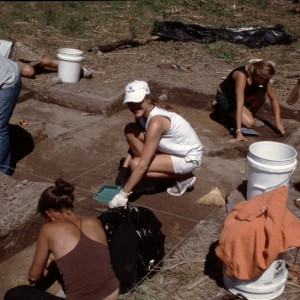The role of the archaeologist in the 21st century is changing. We used to excavate, analyze artifacts and write articles and books. Now we increasingly collaborate with native people, and, in my case, with the clan mothers of two nations of the Haudenosaunee Confederacy, the Cayuga and Onondaga. I recently spent time researching the Corey site, a 16th century Cayuga village about 25 miles north of Ithaca. The site serves as a reminder of the beauty of Cayuga life just before the arrival of Euro-Americans and proves that some historic stories must be told in order for lost cultures to carry on.

Courtesy of Jack Rossen
Corey is a dramatic landscape, situated high along two cliffs overlooking the confluence of three streams. The two-acre village had side-by-side longhouses, a double earthen embankment and a ditch. A path to the gorge below led to an area we believe held the original herb gardens.
The Cayuga were driven out of our area in 1779. As the Revolutionary War ground on, George Washington sent nearly one-third of the Continental Army to burn villages and destroy crop fields and fruit tree orchards. It was an act of scorched earth destruction undertaken for many reasons, including claiming land to pay troops and the geopolitics of westward expansion. At Corey, we recovered plants that had been farmed and collected animal bones that reveal an amazing array of hunting and trapping and a dramatically different environment than we see now that included black bear, elk and passenger pigeon.
The pottery, stone tools, worked animal bone, smoking pipes, jewelry and other artifacts have beauty by themselves, but they also tell about the circulation of people and social relations. Some materials such as feldspar, for tempering ceramics so the clay could withstand firing, and calcite, for soaking dry corn, came from at least 100 miles to the east. Seneca pottery designs on local clay suggest intermarriage with neighboring people to the west.
The most important results, however, are less tangible than artifacts and reconstructions of 16th century Cayuga life. They are lessons learned from clan mothers during the project. They taught about the power and energy of the site, the spiritual danger always present during excavation and the nature of storytelling itself, because more than anything archaeologists are storytellers.
The clan mothers taught me that archaeologists do not find anything, but stories are revealed as the time becomes socially and politically correct. The Haudenosaunee believe that some stories should always be told, as they regularly tell the oral story of the Peacemaker who united the five nations to form the Great Peace a thousand years ago. Other stories should never be told, and thus certain archaeological sites should be left alone.
The time has come to tell the story of the Corey village, because we live at a time where local hate groups argue that the area around the Corey site is not Cayuga homeland, and thus the Cayuga do not have the right to return here to live with us. This belief has had legal attention during the Cayuga Land Claims hearings, in which some argue that the Cayuga homeland was not near Cayuga Lake but only in Canada near Montreal. The archaeological excavations provided immediate local evidence of the Cayuga in Central New York. When I excavated a portion of a heavily disturbed longhouse behind a house in Aurora Village, I could state that, in contrast to the courtroom statements, the Cayuga were our neighbors. Likewise, the Cayuga archaeology allows for human remains from our museums to be returned to the living Cayuga for reburial. These last aspects remind us that archaeology is an endeavor of the present and not merely fun facts about the past.
Jack Rossen is an associate professor of anthropology at Ithaca College. Email him at [email protected].







